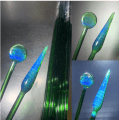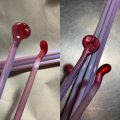- CLOSE-OUTS (SALES)
- BARGAIN BIN
- BEADMAKING & FLAMEWORKING
- ACCESSORIES AND FINDINGS
- BEADHOPPERS
- BEADMAKING CHEMICALS & CONSUMABLES
- BORO BATCH GLASS
- BOROGLOW TUBING
- BOROSILICATE GLASS DECALS by HENDRIXSON
- BULLSEYE GLASS - COE 90
- CHINESE GLASS
- CLEAR BOROSILICATE TUBING & ROD
- COLORADO COLOR COMPANY
- COMPETTITIVE GLASSWORKS
- CREATION IS MESSY (CiM) GLASS
- CRUSHED OPAL TUBING & RODS
- DICHROIC FRIT
- DICHROIC GLASS
- DICRO SLIDE
- DOUBLE HELIX GLASS
- DREAM TUBING CO. - DICHROIC BORO TUBING
- DREAM TUBING CO. - DICHROIC BORO CANE
- EFFETRE GLASS
- FAIRY DUST - SIMULATED DICHROIC
- FRIT BLENDS - SOFT GLASS
- FUMING
- GILSON & DOPALS OPALS
- GLASKOLBEN
- GLASS ALCHEMY GLASS
- GLOW POWDER
- GOLDSTONE & AVENTURINE
- GREASY GLASS
- GROUND GLASS JOINTS
- ACCUGRIND GROUND GLASS JOINTS
- CHINESE CLEAR GROUND JOINTS
- CHINESE COLOUR GROUND JOINTS
- DIFFUSERS
- GERMAN GROUND GLASS JOINTS
- KECK CLIPS
- LENZ GROUND GLASS JOINTS
- QUARTZ GROUND GLASS JOINTS
- THREADED GLASS VIALS
- UNGROUND GLASS JOINTS
- 10mm GROUND GLASS JOINTS
- 12mm GROUND GLASS JOINTS
- 14mm GROUND GLASS JOINTS
- 19mm GROUND GLASS JOINTS
- DEWAR GROUND GLASS JOINTS
- HEAT DEFENSE PADS
- HIGH TEMPERATURE TAPES & ADHESIVES
- KILN MATS - WOVEN
- KUGLER GLASS - 104 COE
- LAMPWORKING KILNS
- LAUSCHA GLASS
- LEAF, FOILS, TUBING, DISCS, WIRE & GRAIN, INSERTS
- LINED TUBING by GOLDEN GATE GLASS
- LUMIERE LUSTERS™
- MICA POWDERS
- MILLEFIORI
- MOMKA GLASS
- MURRINI - GALAXY
- NORTHSTAR GLASS
- OCEANSIDE GLASS & SYSTEM 96 RODS
- ORIGIN GLASS
- PARRAMORE GLASS
- PDX TUBING
- QUARTZ ROD & TUBING
- REDUCTION FRIT
- REDUCTION RODS
- REICHENBACH 104 GLASS
- SAFETY SUPPLIES - EYEWARE, GLOVES, ETC.
- SAMPLE SETS
- STREAKY STRINGERS AND RODS
- THOMPSON ENAMELS
- TAG - TRAUTMAN ART GLASS
- TOOLS - LAMPWORKING
- BEAD CREATORS
- BEAD & MARBLE MOLDS
- BENCH ROLLERS
- BLOWHOSE ADAPTORS (BOOTS)
- BLOWHOSE, SWIVELS, STOPPERS, CORKS
- BLOWPIPES
- CARBON RODS
- CLEANING TOOLS
- CUTTING & SCORING TOOLS
- DESIGN PUSHES
- FINISHING TONGS
- FLARING TOOLS
- FRIT TRAYS, FRIT SIFTERS, FRIT MAKERS
- GRAPHITE PADS
- GROUND GLASS JOINT TOOLS
- HEMOSTATS
- HOLDING FINGERS - GRABBERS
- IMPLOSION TOOLS
- JACKS
- LATHE TOOLS
- MANDRELS
- MARBLE MOLDS
- MASHING TOOLS
- OPTIC MOLDS
- MEASURING & MARKING TOOLS
- PADDLES
- NECKING TOOLS
- PUSHES
- RAKING & POKING TOOLS
- REAMERS
- REPLACEMENT PARTS
- SHAPING TOOLS
- SHEARS
- SOPHIETA or PUFFER TOOLS
- SCULPTING TOOLS
- TWEEZERS & HOLDING TOOLS
- TORCHES, BURNERS AND ACCESSORIES
- BEVELS
- BEVEL CLUSTERS
- EXQUISITE BEVEL CLUSTERS
- GLASSMATE NATURE SERIES
- GST (GLASSMITH) - CLEAR
- GST (GLASSMITH) - COLOURED
- HARMONY BEVELS
- INFINITY BEVEL CLUSTERS
- ANGEL BEVEL CLUSTERS
- ANIMAL BEVEL CLUSTERS
- ASTROLOGY BEVEL CLUSTERS
- BIRD BEVEL CLUSTERS
- CELTIC BEVEL CLUSTERS
- CORNER & BORDER BEVEL CLUSTERS
- FLORAL BEVEL CLUSTERS
- HEART & RIBBON BEVEL CLUSTERS
- HOLIDAY AND OTHER MISC. THEMED BEVEL CLUSTERS
- MUSICAL BEVEL CLUSTERS
- NAUTICAL BEVEL CLUSTERS
- PRIARIE BEVEL CLUSTERS
- PROFESSIONAL BEVEL CLUSTERS
- RELIGIOUS BEVEL CLUSTERS
- STAR BEVEL CLUSTERS
- BOOKS & PATTERNS
- STAINED GLASS PATTERN BOOKS A - D
- STAINED GLASS PATTERN BOOKS E - I
- STAINED GLASS PATTERN BOOKS J - K
- STAINED GLASS PATTERN BOOKS L - Q
- STAINED GLASS PATTERN BOOKS R - S
- STAINED GLASS PATTERN BOOKS T - Z
- ETCHING
- FUSING
- HOLIDAY & RELIGIOUS
- INSTRUCTIONAL & REFERENCE BOOKS
- LAMPS
- LAMPWORKING & JEWELLERY
- MOSAIC & GARDEN
- NATURE & ANIMALS
- PAINTING
- PROJECTS
- STYLES & THEMES
- WINDOWS & DOORS
- CAME, FOIL, METALS
- CHEMICALS
- FRAMING
- FUSING
- ACCESSORIES & FINDINGS
- ADHESIVES
- BULLSEYE GLASS
- CHEMICALS AND CONSUMABLES
- DICHROIC GLASS
- DISPLAY STANDS & WALL MOUNTS
- FRIT BLENDS - 96COE
- FUSIBLE PAPER & DECALS
- FUSING GLASS PACKS
- FUSING KITS
- FUSING MOLDS
- BOTTLE SLUMPING MOLDS
- CASTING MOLDS - COLOUR DE VERRE
- CASTING MOLDS - CPI (CREATIVE PARADISE)
- CASTING RINGS
- DOOR KNOB MOLDS & HARDWARE
- DROP, DRAPE and SLUMP MOLDS
- LAMP MOLDS
- NOVELTY MOLDS
- OVAL MOLDS
- POT MELT MOLDS
- RECTANGULAR MOLDS
- RELIGIOUS THEMED MOLDS
- ROUND MOLDS
- STAINLESS STEEL MOLDS
- STAND-UP MOLDS
- SQUARE MOLDS
- TEXTURE MOLDS
- WEAVE MOLDS
- FUSING TOOLS
- GLOW FRIT (FUSING)
- GLASSLINE PAINTS
- KILNS & ACCESSORIES
- KILN MATS - WOVEN
- MICA POWDERS & FAIRY DUST (SIMULATED DICHROIC)
- MILLEFIORI & MURRINE
- OCEANSIDE COMPATIBLE & SYSTEM 96 GLASS
- OVERLAYS for FUSED & STAINED GLASS
- PRE CUT FUSIBLE GLASS SHAPES
- SAFETY SUPPLIES - EYEWARE, GLOVES, ETC.
- THOMPSON ENAMELS
- TWISTED CANE
- WALL MOUNTING SYSTEMS
- WISSMACH 96 FRITS
- GLASS SHEETS - FUSIBLE
- GLASS SHEETS - NON FUSIBLE
- GRINDERS, BANDSAWS, CAME SAWS
- HAND TOOLS
- JEWELRY
- JEWELS, GLOBS, RONDELS
- LAMP BASES & ACCESSORIES
- MERCHANDISE
- MOSAIC & PATIO STONE
- PAINTING
- STAINED GLASS BEGINNER KITS
- SUNDRIES
FUSE MASTER ENAMELS
Fuse Master Enamels are different than glass frits or powders in that they have a very heavy colour density. In most cases a fairly thin layer of enamel will provide a very dense area of colour. Although in some instances, if the application is too thin, the enamels can disappear after firing.
Fusemaster enamels are sold as finely ground powers that can be mixed with most any type of binder to accommodate a wide range of applications. The following binders are recommended:
Water base binders:
Fuse Master Water Friendly Medium, Fuse Master Pate-de-Verre glue, Fuse Master Liquid Stringer Medium, Fuse Master Airbrush Medium, Fuse Master Silkscreen Medium and Gum Arabic.
Oil base binders:
Pine Oil, Clove Oil, Squeegee Oil, Lavender Oil, Painting Medium and Decal Medium.
GENERAL CHARACTERISTICS:
Fuse Master Enamels can be used on a wide range of base glasses including float/window, Uroboros, Bullseye, Blenko, Spectrum, Wissmach, Armstrong, Chicago Art Glass Youghiogheny, Wasser, Kokomo and Effetre. They do not work with Pyrex.
The enamels are a finely ground glass powder so it is important not to inhale them. Wear an approved respirator when working with this product. Keep your work area free of enamel dust. Keep the enamels away from children.
APPLICATIONS:
Fuse Master enamels are designed to be used during a fuse or slump firing. They can be placed on the surface of the glass being fired or most (not reds) can be laminated between two or more layers of glass. Each method of application and the location of the enamels will produce a different visual effect.
Dry Sifting: Place a stencil onto the glass to be decorated and sift the enamels through a screen. For greater durability before firing, first cover the base glass with a light coating of a 50/50 mix of water and Fuse Master Water Friendly Medium, then place the stencil onto the glass and sift the enamels. This is a good technique to use for repetitive designs, gradations of colour and transitions from one colour to another.
Air Brushing: Mix the enamels equal parts powder to Fuse Master Airbrush Medium. You can go up to two parts air brush medium if that works better with your set up. You can also use water and another binder, like Water Friendly Medium. Mix these about 5 or 6 water to one medium. In either case, try to keep the enamels to liquid ratio close to equal.
Place your glass at about a 60 degree angle so it is not straight up and down. Start with a smooth even stroke across the glass, then let it dry. You can get more than one pass in before drying, but you do not want to be so heavy that it runs. If it runs you have to wipe it all off and start over again. Use a warm room and a blow dryer to speed up drying time. Repeat, light coat - dry - light coat - dry until you have a coating that is slightly heavier than you think you need. The enamels will lose about 10% of their density when fired. Keep the solution stirred to avoid clogging the air brush.
Painting: Fuse Master enamels can be applied using a variety of painting methods such as tracing, stippling, flood coating and as a colour wash. The powder can be mixed into a liquid by adding any of the binders listed above. The exact ratio of powder, binding and thinner will vary so it is best to run some tests before embarking on a project.
Screen Printing: Mixing the enamels with Fuse Master Silkscreen Medium will produce an excellent pigment for direct silk screening onto glass. Mix roughly equal parts by weight – enamels and medium. The mixture should be as thick as pancake batter. Use a decal medium if you are producing fire-on decals.
Bead Making: LF enamels are an excellent addition to a bead maker's palette. Place a small pile of the enamels on a flame proof surface. Heat the base glass of your choice on a mandrel and roll the hot glass through the powder. Be careful on the next reheat not to burn out the colour. The enamels may be added as a last step or they may be encased with a layer of clear.
Glass Blowing: LF enamels add a strong rich colour to blown piece. They can be sifted onto hot glass or they can be picked up by rolling though the powder. It is best to case the enamels before the glass is worked again.
Because of their low maturing temperature, enamels that are in contact with a mold or kiln shelf will stick to kiln wash or fiber paper.
When working with these or any other product for the first time, test firings are always recommended as a way to study subtle variations of performance. Keep good firing records so that successes can be duplicated.






